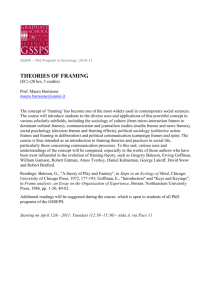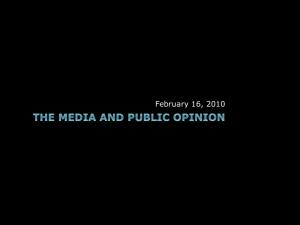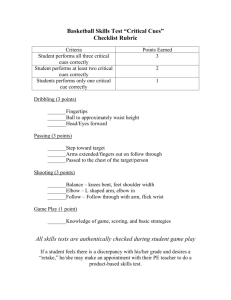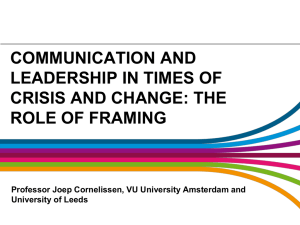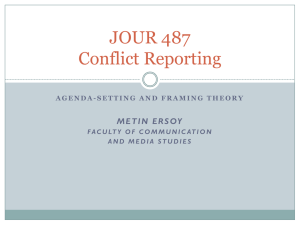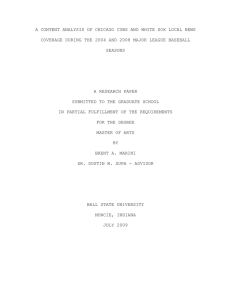Journalism 614: Communication and Public Opinion
advertisement
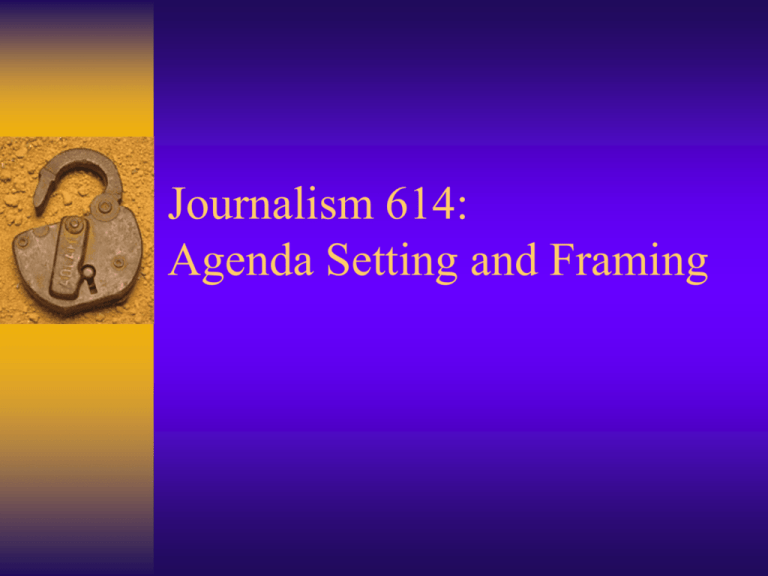
Journalism 614: Agenda Setting and Framing Categories of Effects: 1. Agenda Setting 2. Priming 3. Cueing 4. Framing Agenda Setting is …the process by which problems and alternative solutions gain or lose public and elite attention. …a fierce competition because we cannot consider every issue at once because the public’s “carrying capacity” is too small Why is Agenda Setting Important? E. E. Schattschneider: ‘The definition of the alternatives is the supreme instrument of power” Control over agenda means control over outcomes Agenda setting is therefore about getting on the agenda, and about keeping things off of it. The Foundations of a Paradigm Rejection of persuasion – Focus on cognitive processes Rediscovery of powerful effects – Response against the limited effects paradigm Interest in media--politics interface and conditions under which effects occur Agenda Setting Agenda-setting – “telling us what to think about” (Cohen) – Identified with McCombs & Shaw (1972) – Emphasis on how the media shapes public opinion concerning the relative importance of issues – Indicators of media emphasis • • • • • Attention (frequency and length of stories) Placement (top story, “above the fold”) Content cues (headlines, photos, tone) Number of sources / Number of outlets Others? Four Phases of Research Nearly 300 published studies – First phase - publication of McCombs & Shaw’s original research - coin the term – Second phase - follow-up to confirm the effect and discover contingencies – Third phase - new domains - agenda of candidate character and personal concerns – Fourth phase - attention to the sources of the media agenda - inter-media effects How Issues Reach the Agenda Group conflict Leadership activity Protest movements Media coverage or activity Changes in indicators Political changes Crises and Focusing Events Special Role of Focusing Events “a rare, sudden, well-known, actually or potentially harmful event.” – Mass Shooting, Earthquake, Govt Shutdown… Tend to induce sudden attention to issues Can trigger intensive group interest/activity Focusing events can fade fast off agenda Studying Agenda Setting Time-order is key – Media shape public agenda? – Media follow public agenda? – Both respond to something else • Institutional prompting • Objective reality – Studies show that there is a time-ordered connection between media and public agenda • Cross-lagged correlations - arbitrary time lag • More sophisticated studies improve early methods Major Questions Who sets the public agenda, and under what conditions is this effect likely to occur? Who sets the media agenda, and which media direct the agenda-setting process? Who sets the agendas of interest groups, leaders, and policy makers? Contingent conditions Need for cognition/orientation – Increases agenda setting through media surveillance Political involvement/interest – Increases agenda setting through news use Issue abstraction – More pronounced for abstract issues Personal viewpoints – Increases when consistent with personal orientation Interpersonal discussion – Reduces media dependence for agenda development Setting the media agenda Intermedia agenda setting - influence that agendas of different media have on each other Political advertising — and political elites — drive the agenda of all news organization National news agencies have been found to drive the agenda of local news agencies National newspaper have been found to drive the agenda of television networks and digital outlets Setting the elite agenda Reciprocal causation between journalists and policy makers - both have influence Media coverage can help shape the agenda of policy-makers – However, these effects do not appear to ultimately affect policy making itself Elites pay attention to the public agenda that the media helps to establish Problems with Agenda Setting Trouble linking evidence to key theories of society, news work, and human psychology – Often focused on aggregate level effects – shift in issue priorities across the population – and rely on incomplete psychological explanations – Failure to fully integrate content and effects in coherent studies of media effects • Limited experimental evidence Questions about Digital Media May lessen the agenda-setting effects – More content choice – More control over content – More outlets and opinions Blogs, in particular, rely on media agenda – This may strengthen agenda setting effects Priming (Iyengar & Kinder) Drawing attention to an issue can change the criteria used to evaluate political leaders – Issues high on the public agenda serve as basis for judging the success or failure of elites – Short-term effect or long-term effect? – Priming in politics may have profound effects • E.g., Media attention to Persian Gulf war primes positive evaluation of Bush Presidency which reversed when focus was shifted back to the economy (Krosnick) Priming Issues Increasing attention to effects of priming on other issues through the “spread of activation” Encountering moral-ethical issues changes how people understand other issues they encounter – Come to understand other issues in ethical terms Can also prime particular candidate characteristics – Focus on issues can prime judgments of competency or integrity, depending on the issue Second Level Agenda-Setting Revised version of the theory Media tell us how and what to think – Attention to particular attributes Sounds like framing – “to frame is to select some aspects of a perceived reality and make them more salient in a communication text” - Entman Framing Two broad traditions – Sociological - Outcome of news work • The process of news production – Psychological - Categories of the mind • The process of audience consumption Framing and Cueing The power of language to shape thought – Frames - broad organizing principles • Idea used to structure a news story • Journalistic decision – Cues - labels and categories • Word or phrase with rhetorical value • Contested by elites Framing and Cueing Episodic vs. Thematic frames Strategy vs. Policy frames Ethical vs. Material frames Individual vs. Societal frames Pro-life vs. anti-abortion Estate tax vs. death tax Terrorists vs. insurgents Episodic vs. Thematic Iyengar, 1991 – Media tend to present social problems in episodic terms (individual, short-term) instead of thematic terms (collective, long-term) – This patterns encourages audiences to attribute responsibility for solving the problem to the individual instead of the collective Strategy vs. Policy News coverage tends to focus on the game of politics, and the competition between players, instead of the features of policy – Particularly true during elections Leads to audience cynicism and may contribute to the erosion of efficacy Ethical vs. Material News media tend to construct issues in terms of opposing rights / moral principles, as opposed to economics or pragmatics Encourages simplified electoral decision making and character attributions Individual vs. Societal News media tend to frame issues at the individual level, as opposed to the societal level, due to dominant news values This frame distinction interacts with other coverage elements to influence the complexity of thought, tolerance judgments News Norms and Frame Effects These dominant news norm of focusing on specific episodes over broader themes, political strategy over policy, matters of principle over pragmatics, and individuals over groups all reduce citizen competence – What does this say about the work of journalists? How might they change? Frames and Cognitive Processing Message frames interact with: – Audience predispositions and knowledge – Framing effects are not uniform • Different for different people Cognitive structures (schemas): – Constellations of knowledge used to organize processing of new info (e.g., news stories) • Organized into associated networks of information • Developed through past experiences, information exposure, and social interactions Associative Networks Networks of interrelated constructs – Frames/cues activate mental constructs Construct activation from interconnected network – Spread of activation through associated nodes Complexity of activated thoughts – Concerned with form, as opposed to content, of memory – Complexity as an indicator of political sophistication? Model of Framing Effects Source and Language Cues Source cues - who is making the comment? – Conservative or Liberal – Black or White – Different leaders Language cues - what labels are used? – Urban sprawl vs. Suburban development – Pro-Choice vs. Abortion Advocates – Insurgent vs. Terrorists Powerful Cues Recast Debates Get in Groups of three to four: – Pick a set of cues that has defined the debate about a specific policy or product – Pick a policy debate or product category and discuss how the cues have defined this choice Ex. Partial Birth Abortion vs. Late Term Abortion Frames and Cues Interact Organizing devices and source or language cues work together to influence judgment – Tolerance judgments affected by individual frame combined with “othering” cues How might they work together to influence tolerance and the desire to speak out? Get Back in Groups: Come up with an example of how a news frame and elite cue might work together to sway opinion in particular ways. – Can stick to the cue you had in mind or pick new one


